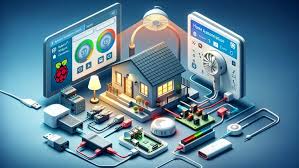Use Raspberry Pi and Windows 10 to build a home automation system that can operate home devices automatically
SUMMERY
The course on building a home automation system using Raspberry Pi and Windows 10 IoT is designed to help learners automate their home devices such as lights, fans, and wall sockets. By leveraging modern technology, this course makes automation accessible to anyone interested in creating a fully automated home environment.
Overview of the Course
In this course, students will learn how to build a home automation system that operates various home devices using Raspberry Pi as the central control hub, with Windows 10 IoT Core as the operating system. Windows 10 IoT Core is ideal for small, smart, and secure devices, and it facilitates the incorporation of AI and machine learning at the edge. The course will guide students in integrating Arduino UNO with the Raspberry Pi to control and monitor sensors and devices. The Arduino collects sensor data, while the Raspberry Pi communicates with the Arduino through the I2C protocol.
The course is structured to give a step-by-step guide on connecting devices like temperature sensors, PIR sensors, and light-dependent resistors (LDRs), along with other controllable appliances such as lights and fans. The process of coding each component is thoroughly explained, so learners can gain a comprehensive understanding of building such systems.
Why Use Windows 10 IoT Core?
Windows 10 IoT Core is chosen for its scalability, security, and manageability, especially for small devices. It provides the necessary infrastructure to develop and maintain IoT devices over time, helping to bring AI and machine learning capabilities to these systems. Its out-of-the-box functionalities make it a good fit for quick development cycles, and it ensures that the connected devices remain secure.
I²C Communication Protocol
A major component of this course is mastering the I²C (Inter-Integrated Circuit) communication protocol. I²C is a widely used communication protocol that allows multiple devices to communicate over just two wires, making it highly efficient and minimizing wiring complexity. In this system, the Raspberry Pi acts as a master device that sends requests for sensor data to the Arduino, which acts as a slave. The I²C protocol is ideal for controlling multiple sensors and devices in a home automation system, making it essential knowledge for electronics hobbyists and professionals.
The course provides an in-depth explanation of how I²C works, how to set it up between the Raspberry Pi and Arduino, and how to program both devices for effective communication. The I²C protocol has been in use since the early 1980s and remains popular for its simplicity and versatility, making it ideal for applications like this home automation system.
What You Will Learn
By the end of the course, students will have acquired the skills to:
- Build a fully functioning home automation system using Raspberry Pi and Windows 10 IoT Core.
- Automatically control home devices such as lights, fans, and sockets.
- Use Arduino UNO to gather sensor data and control devices.
- Implement and manage I²C communication between Arduino and Raspberry Pi.
- Connect and code multiple sensors (such as PIR sensors, temperature sensors, and LDRs) and devices step-by-step.
Who Should Take This Course?
This course is designed for a range of individuals, from electronics enthusiasts to professional engineers. It caters to:
- Electronics hobbyists who want to explore home automation using modern technologies.
- Makers who are looking to expand their skills with Raspberry Pi, Windows 10 IoT, and Arduino.
- Engineering students who want to gain hands-on experience with the Internet of Things (IoT).
- Beginners interested in understanding I²C communication between microcontrollers and microcomputers.
Requirements
The course requires a basic understanding of electronics, specifically Raspberry Pi, Arduino, and programming fundamentals. Participants will need to have access to a Raspberry Pi board, Arduino UNO, and the necessary sensors and peripherals to follow along with the course.
About the Instructor
The course is taught by the Educational Engineering Team, a group of experienced engineers with over 13 years of expertise in microcontrollers and programming. They are known for their clear, step-by-step teaching style, which simplifies even complex concepts for students. The team has already helped over 250,000 students and offers more than 100 courses on topics like circuit design, programming, and industrial automation. The lead instructor, Ashraf, is a Mechatronics engineer and electronics hobbyist with years of experience in creating online video content and educational materials on topics related to Arduino, Raspberry Pi, and home automation.
Conclusion
This course provides a comprehensive guide for anyone interested in building a home automation system using Raspberry Pi and Windows 10 IoT. Whether you’re a hobbyist looking to control home devices or an engineering student seeking practical IoT experience, the course offers a well-structured, step-by-step approach to mastering the necessary tools and techniques.
What you’ll learn
-
How this Home Automation Device is structured, user interface, device connection and working principle.
-
Managing Different Rooms
-
Device Addressing: Address Mapping
-
What is the difference between I²C and other communication methods
-
Circuit Connection
-
Controlling High power loads via Arduino
-
Software Needed to Code Arduino and Raspberry Pi
-
Communication Protocol
-
Raspberry Pi and Arduino communication
-
Windows 10 IoT User Interface
-
Arduino Coding
-
Visual Studio User Interface and Raspberry Pi Coding
-
What is I²C and how it works
-
What You Need to Get things done
-
Tips and Tricks and Helpful Resources
-
I2C Communication Protocol
-
Device Address Mapping
-
How to code I²C the right way and how to talk to multiple devices easily
-
Code and Circuit Schematics to connect Arduino and Raspberry Pi
-
Communication Protocol between Raspberry Pi and Arduino
-
Tips and Tricks
-
Advantages of I²C and Disadvantages of I²C
-
I²C Operation
-
Main I²C Bus Library Functions
-
How to implement I²C in your project
-
Why using I²C will make your life easier
-
Known Issues
Course content
Requirements
-
Internet Connection
-
Computer, Laptop, Mac or Chrome device
-
A basic knowledge in C Programming language
Description
Use Raspberry Pi and Windows 10 to build a home automation system that can operate home devices automatically.
Today, technology is enhancing human life. Technology is evolving in a very fast manner. Automation was an idea and a dream but not today. By combining the latest technologies with Home Devices, Everyone can build A Fully Automated Home. With the Raspberry Pi and Windows 10 IoT, we can build a home automation system that is capable of handling and operating any of your home devices automatically.
In this course, an Arduino UNO will be used to control different devices and read different sensor data. Raspberry Pi will send requests for Arduino UNO to get the sensor data collected.
Each room can have multiple controllable devices (Light, Fan, Wall Socket), PIR Sensor, temperature sensor, and LDR. We will explain how to connect everything and how to code each part in a step-by-step manner.
Why we are using Windows 10 IoT Core:
- Built for small, secure, smart devices: The smallest Windows 10 operating system still has the manageability and security expected from Windows.
- Smart: Easily bring Artificial Intelligence (AI) and Machine Learning (ML) to the edge with Windows.
- Secure: Help keep devices secure for the long term.
- Fast: Quickly get IoT devices to market and maintain for the long term with out-of-the-box OS.
What about Communication Protocols?
- I²C (pronounced I-squared-C): Allows communication of data between I2C devices over two wires, making it easier for anyone to exchange information without too much wiring.
- I2C Communication between Arduino and Raspberry Pi: A step-by-step guide to Master I2C Protocol and Start using it to connect your Arduino and Raspberry Pi.
In today’s world, every electronics hobbyist works with Arduino and Raspberry Pi to do their projects. With the introduction of Windows 10 IoT Core, Microsoft is also into the embedded world. Today Internet Of Things is a buzzword, but for basic things, we need an Arduino to communicate with a Raspberry Pi. In this course, I will explain how to communicate the Arduino with the Pi using an I2C bus and Windows 10 IoT Core.
I2C communications have become the de facto method of communicating between microcontrollers, microcomputers, and a variety of integrated circuits and sensors. It has been around since 1982 and was originally developed for use in television receivers.
Join this course now and start building your fully automated home using Raspberry Pi and Windows 10 IoT.
What you will learn
- Build a home automation system using Raspberry Pi and Windows 10 IoT.
- Control various home devices (lights, fans, wall sockets) automatically.
- Use Arduino UNO to read sensor data and control devices.
- Connect and code multiple controllable devices and sensors step-by-step.
- Implement I2C communication between Arduino and Raspberry Pi.
- Understand and use Windows 10 IoT Core for small, secure, and smart devices.
Who is this course for
- Electronics enthusiasts interested in home automation.
- Hobbyists and makers looking to expand their skills with Raspberry Pi and Windows 10 IoT.
- Engineering students and professionals wanting to learn about IoT.
- Anyone interested in building and controlling automated home systems.
Requirements
- Basic understanding of Raspberry Pi, Arduino, and electronics.
- A Raspberry Pi board, Arduino UNO, and necessary peripherals.
- Basic programming knowledge is helpful but not required.
About the Instructor
Educational Engineering Team
Team of skilled Engineers Sharing Knowledge with the World
Educational Engineering Team is a Leading Team in the Microcontroller Industry, with over 13 Years of Experience in Teaching and Doing Practical Projects.
We strive to put all our hands-on experience in these courses. Instead of superficial knowledge, we go into the depth of the topic and give you the exact step-by-step blueprint on how to tame simple as well as complex topics in easy and digestible bite-sized videos.
This real-world knowledge enables you to grasp knowledge easily, and you can apply this learning immediately to your life and projects.
Educational Engineering Team has been in the Programming and Microcontroller business since 2007. We have been part of many projects. Over the course of these years, we have gained a good insight into students’ and educators’ needs. We are passionate about sharing all our collective knowledge with you. As of 2018, we have already taught over 250k-THOUSAND students and counting.
Currently, we have more than 100+ Courses on Udemy
Educator and Author of “Educational Engineering”.
Ashraf is an educator, Mechatronics engineer, electronics and programming hobbyist, and Maker. He creates online video courses on the EduEng YouTube Channel (More Than 4 Million View, 20k+ Subscribers) and is the author of four Microcontroller books.
As a Chief Educational Engineer since 2007 at Educational Engineering Team, the company he founded, Ashraf’s mission is to explore new trends and technology and help educate the world and make it a better place.
Educational Engineering offers educational courses and Bootcamps, articles, lessons, and online support for electronics hobbyists, Programming hobbyists, Microcontroller hobbyists, STEM students, and STEM teachers.
That team also works as freelancer engineers, helping many students in their graduation projects, and providing guidance and consulting for many students over the years to help them kick-start their careers.
Ashraf’s core skill is explaining difficult concepts in a step-by-step, easy-to-understand manner using video and text. With over 11 years of tertiary teaching experience, Ashraf has developed a simple yet comprehensive and informative teaching style that students from all around the world appreciate.
His passion for Microcontrollers and Programming, particularly for the world of Arduino, PIC Microcontroller, and Raspberry Pi, has guided his personal development and his work through Educational Engineering.
Ashraf’s online courses have helped over 250,000 people from around the world to improve and make great careers in the industry.
Educational Engineering Team offers Courses on:
- Circuit Design, Simulation, and PCB Fabrication
- Arduino, PIC Microcontroller, and Raspberry Pi
- Programming in C, Python, and other programming languages
- PLC Industrial Programming and Automation
- 3D Design and Simulation
- ESP and IoT World
Who this course is for:
- Anyone Interested in Learning How to learn Home Automation Using Raspberry Pi And Windows 10 IoT
- Anyone Interested in Learning How to Control Home devices using a beautifully created User Interface by Combining the power of Raspberry Pi with Windows 10IoT
- Anyone Interested in Learning I2C Communication between Arduino and Raspberry Pi
- Anyone Interested in Learning I2C Communication in A Step by Step Manner
- Anyone Interested in Learning Arduino I2C Communication
- Anyone Interested in Learning Raspberry Pi I2C Communication
- Anyone interested in talking to multiple devices easily via I²C the right way
- Anyone Interested in Interfacing Arduino with other ICs or devices via I²C
- Anyone Interested in Controlling different devices using I²C Protocol
- Arduino Lovers
- Raspberry Pi Lovers










